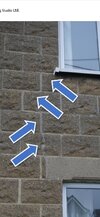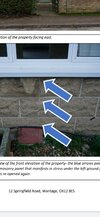- Joined
- 12 Jan 2023
- Messages
- 7
- Reaction score
- 0
- Country

Hello All,
I'm in the process of buying a 1920"s detached house and had a Level 3 RICS survey which picked up on cracks in the brickwork. The property is made from reconstituted stone, which is very weather worn and several of the blocks have split as well as the mortar in a diagonal and vertical pattern.
A structural engineers report highlighted roughly half (modern) foundation depth on a clay soil next to a moisture sapping beech hedge and diagnosed subsidence. However, several other RICS and mortgage surveyors plus an experienced builder have said nonsense, the cracks are caused by removal of structural windows at some point in the past.The property is fitted with large, concrete lintels.
My question is, is it possible for cracks to appear in a wall due to structural window replacement even if there are lintels present?
The crack in the second picture stops St an air brick and doesn't go through the damp proof course.
I'm totally confused and would appreciate any opinions.
I'm in the process of buying a 1920"s detached house and had a Level 3 RICS survey which picked up on cracks in the brickwork. The property is made from reconstituted stone, which is very weather worn and several of the blocks have split as well as the mortar in a diagonal and vertical pattern.
A structural engineers report highlighted roughly half (modern) foundation depth on a clay soil next to a moisture sapping beech hedge and diagnosed subsidence. However, several other RICS and mortgage surveyors plus an experienced builder have said nonsense, the cracks are caused by removal of structural windows at some point in the past.The property is fitted with large, concrete lintels.
My question is, is it possible for cracks to appear in a wall due to structural window replacement even if there are lintels present?
The crack in the second picture stops St an air brick and doesn't go through the damp proof course.
I'm totally confused and would appreciate any opinions.


